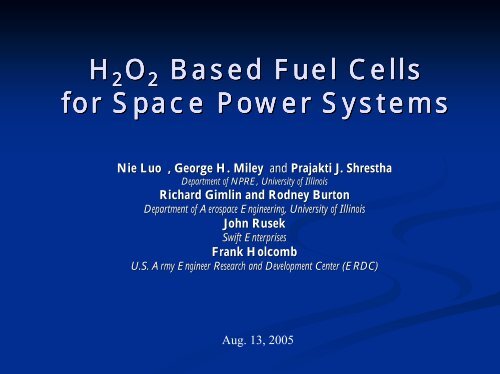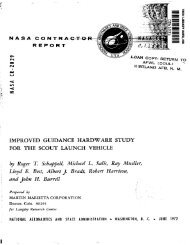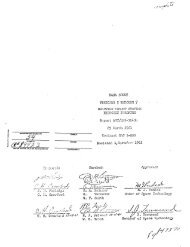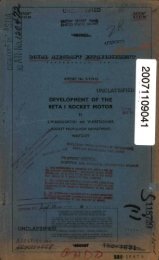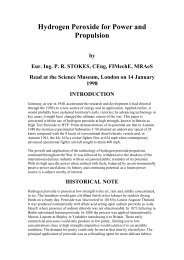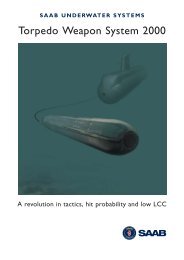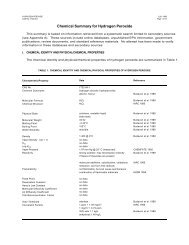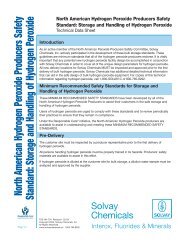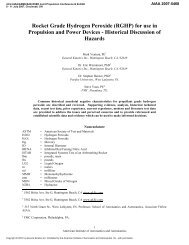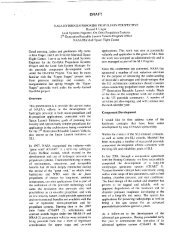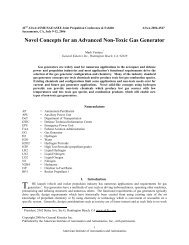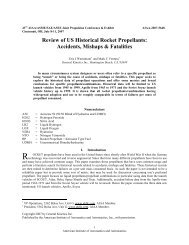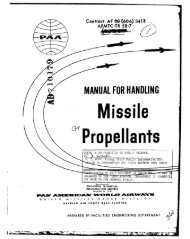U-of-Ill-H2O2-Based-Fuel-Cells-2005 - hydrogen-peroxide.us
U-of-Ill-H2O2-Based-Fuel-Cells-2005 - hydrogen-peroxide.us
U-of-Ill-H2O2-Based-Fuel-Cells-2005 - hydrogen-peroxide.us
Create successful ePaper yourself
Turn your PDF publications into a flip-book with our unique Google optimized e-Paper software.
H 2 O 2 <strong>Based</strong> <strong>Fuel</strong> <strong>Cells</strong><br />
for Space Power Systems<br />
Nie Luo , George H. Miley and Prajakti J. Shrestha<br />
Department <strong>of</strong> NPRE, University <strong>of</strong> <strong>Ill</strong>inois<br />
Richard Gimlin and Rodney Burton<br />
Department <strong>of</strong> Aerospace Engineering, University <strong>of</strong> <strong>Ill</strong>inois<br />
John R<strong>us</strong>ek<br />
Swift Enterprises<br />
Frank Holcomb<br />
U.S. Army Engineer Research and Development Center (ERDC)<br />
Aug. 13, <strong>2005</strong>
Introduction<br />
Desired Properties <strong>of</strong> H 2 O 2<br />
Powerful<br />
H 2<br />
O 2<br />
is one <strong>of</strong> the most powerful oxidizers. Through catalysis, H 2<br />
O 2<br />
can be converted into hydroxyl<br />
radicals (OH⋅) with reactivity second only to fluorine. By <strong>us</strong>ing catalysts such as Fe 2+ , H 2<br />
O 2<br />
can be readily<br />
converted into hydroxyl ion (OH – ), which makes it a desired reactant for a fuel cell (FC). Combined with<br />
different fuels, H 2<br />
O 2<br />
forms a potent rocket propellant. With <strong>hydrogen</strong> the specific impulse is over 322 seconds<br />
in vacuum.<br />
Safe<br />
H 2<br />
O 2<br />
is a natural metabolite <strong>of</strong> many organisms. When decomposed it gives only oxygen and water. H 2<br />
O 2<br />
is also formed by the action <strong>of</strong> sunlight on water, a purification system <strong>of</strong> Nature.<br />
Widely Used<br />
H 2<br />
O 2<br />
is now produced at over a billion pounds per year. The high volume production results in very low<br />
cost.
The <strong>us</strong>e <strong>of</strong> <strong>hydrogen</strong> <strong>peroxide</strong> in FC’s is a relatively new development,<br />
We have done a lot <strong>of</strong> study on it and got some results. All our results<br />
have shown the general feasibility <strong>of</strong> a <strong>peroxide</strong> based electrochemical<br />
cell. A typical FC utilizes air as the oxidizer and therefore H 2 O 2 was<br />
not studied for applications where air is readily available, such as<br />
ground transportation For space or underwater applications, H 2 O 2<br />
based systems (whether heat engine or FC based) are an ideal choice.<br />
Reasons ?<br />
A,B
A . H 2 O 2 Compared to Other Oxidizers<br />
Liquid oxygen (LOX)<br />
- LOX is <strong>us</strong>ed as rocket propellants. It is environmentally sound, but is not suitable<br />
for long-time storage due to its vaporization.<br />
N 2<br />
O 4<br />
- The <strong>us</strong>e <strong>of</strong> N 2<br />
O 4<br />
in a FC should be very restricted beca<strong>us</strong>e <strong>of</strong> it extreme toxicity.<br />
Bottled high-pressure oxygen<br />
- Its storage efficiency is rather low (<strong>of</strong>ten ~ 0.3 kg/liter).<br />
H 2<br />
O 2<br />
- storable<br />
- biologically sound and environmentally compatible<br />
- high energy density <strong>of</strong> concentrated H 2<br />
O 2<br />
- It is readily catalyzed in a controlled reduction and greatly enhances the overall FC efficiency.<br />
- Control <strong>of</strong> output power can simply involve changing the concentration <strong>of</strong> the aqueo<strong>us</strong> H 2<br />
O 2<br />
solution.<br />
Th<strong>us</strong>, short time overloading or pulsing can be achieved by increasing the H 2<br />
O 2<br />
concentration at the<br />
cathode side.
B. Benefits <strong>of</strong> H 2 O 2 in <strong>Fuel</strong> <strong>Cells</strong><br />
Higher current density from larger oxidizer mass density<br />
The mass density in a gas phase is ordinarily a tho<strong>us</strong>and times less than in a liquid phase, <strong>peroxide</strong> fuel<br />
cells have the potential for a higher area current density (a volume density difference <strong>of</strong> 1000 times<br />
translates into an area density difference <strong>of</strong> 100 times).<br />
Single-phase transport on the cathode side <strong>of</strong> FC increases reaction rate<br />
Two-phase mass transport <strong>of</strong> reactant is the limiting phenomenon <strong>of</strong> traditional FC operation. And water<br />
generated in the cathode reaction can condense and block the open pores <strong>of</strong> the gas diff<strong>us</strong>ion layer,<br />
limiting reactant transport. By shifting to a liquid phase reactant, the direct H 2<br />
O 2<br />
FC largely bypasses<br />
these transport problems.<br />
Eliminating the O 2<br />
reduction over-potential problem<br />
The oxygen reduction reaction at the cathode is written as:<br />
O 2<br />
+ 4 H + + 4 e - → 2 H 2<br />
O<br />
This reaction involves the simultaneo<strong>us</strong> transfer <strong>of</strong> four electrons, therefore has a low probability <strong>of</strong><br />
occurrence.<br />
In comparison, the H 2<br />
O 2<br />
reduction process at the cathode,<br />
H 2<br />
O 2<br />
+ 2 e - → 2 OH – ,<br />
is a two-electron-transfer process involving a much lower activation barrier. This improvement therefore<br />
circumvents the over-potential problem <strong>of</strong> a H 2<br />
/O 2<br />
fuel cell.
Experimental Set-up and Results<br />
A. Fabrication <strong>of</strong> the Peroxide <strong>Fuel</strong> Cell<br />
MEA<br />
-nafion 112 membrane is <strong>us</strong>ed as the<br />
electrolyte.<br />
-carbon supported Pt catalyst<br />
-reactant diff<strong>us</strong>ion layer<br />
Perforated stainless steel plates<br />
Bolts, Nuts<br />
Two polycarbonate end plates<br />
Liquid-tight seal (silicone elastomer)<br />
Fig. 1<br />
The prototype H 2 /H 2 O 2 FC outperforms an<br />
ordinary H 2 /O 2 FC at room temperature and<br />
ambient pressure.
B. Performance <strong>of</strong> Peroxide FC<br />
Liquid reactants : 20%-wt NaBH 4<br />
stabilized with 1.8 M potassium hydroxide (KOH)<br />
20%-wt H 2<br />
O 2<br />
stabilized with 5%-wt phosphoric acid<br />
Fig. 2<br />
The V-I characteristics <strong>of</strong> vario<strong>us</strong> FC’s at room temperature, and ambient pressure<br />
operation. Note the prominent H 2 O 2 FC performance. The curve for the H 2 /H 2 O 2<br />
fuel cell is tested with a pH=2 catholyte.
Observations<br />
Both <strong>peroxide</strong> fuel cells have a higher open circuit voltage than that<br />
<strong>of</strong> a typical H 2 /O 2 PEM FC (< 1 V)<br />
The open circuit voltage, in both cases, is higher than the 1.23 V<br />
ideal potential <strong>of</strong> a <strong>hydrogen</strong>/oxygen FC. This is an unambiguo<strong>us</strong><br />
evidence for the “direct” reduction <strong>of</strong> <strong>hydrogen</strong> <strong>peroxide</strong> at the<br />
cathode.<br />
Although the absolute cell voltage is high for the <strong>peroxide</strong> FC’s, it is<br />
not very impressive compared to the theoretical potential. For example,<br />
the 1.4 V open-circuit voltage <strong>of</strong> the NaBH 4 /H 2 O 2 FC is only 62% <strong>of</strong><br />
that theoretically achievable.
The small <strong>peroxide</strong> fuel cell prototype can readily drive a watt-level electric<br />
motor<br />
Fig. 3 a <strong>peroxide</strong> FC drives an electric motor.<br />
On the left side, the electrolyzer was turned <strong>of</strong>f so that no <strong>hydrogen</strong> was<br />
generated to feed the FC. Th<strong>us</strong>, the propeller was at rest. On the right, the<br />
FC is now fed with <strong>hydrogen</strong>, and the propeller starts rotating.
Power density <strong>of</strong> 0.6 W/cm 2 was achieved with the H 2<br />
/H 2<br />
O 2<br />
FC while the NaBH 4<br />
/H 2<br />
O 2<br />
FC reached 0.8 W/cm 2 , both at room temperature and ambient pressure<br />
Table 1 Performance <strong>of</strong> UIUC/NPL <strong>peroxide</strong> FC’s at 1 atm. and 300K<br />
Type<br />
Ideal Energy<br />
Density (W·hr/kg)<br />
Voltage<br />
(Open circuit)<br />
Current<br />
(Short circuit)<br />
Max. power<br />
density<br />
Efficiency @<br />
100 mA/cm 2<br />
H 2<br />
/H 2<br />
O 2<br />
2728<br />
>1.05 V >1.8 A/cm 2 >0.6 W/cm 2 >55%<br />
NaBH 4<br />
/H 2<br />
O 2<br />
2580<br />
>1.40 V >3.0 A/cm 2 >0.7 W/cm 2 ~55%<br />
The experimentally achieved energy density is around 1000 W·hr/kg, which is<br />
significantly higher than that <strong>of</strong> ordinary batteries. This opens up a range <strong>of</strong><br />
possible applications other than the space type
With the <strong>us</strong>e <strong>of</strong> all-liquid reactants in the Borohydride/<strong>peroxide</strong> FC, the<br />
fuel/oxidizer management becomes a very simple task, so the storage can<br />
be kept light and compact.<br />
1. No water humidifier is needed beca<strong>us</strong>e the Nafion PEM is 100% saturated<br />
with water<br />
2. The liquid reactant <strong>of</strong>fers a fairly large heat removal capacity so that<br />
separate liquid cooling loop is not needed
A unitized RFC( regenerative fuel cell) appears<br />
quite feasible for a NaBH 4 /H 2 O 2 fuel cell, and initial<br />
experiment at that direction are quite encouraging.<br />
Indeed, the very first regenerative operation in the<br />
UIUC/NPL prototype NaBH 4 /H 2 O 2 FC has reached<br />
an energy density <strong>of</strong> 65 W·hr/kg, with enormo<strong>us</strong><br />
potential for future growth.
C. Performance Summary<br />
From a performance point <strong>of</strong> view<br />
1) Very high energy density (over 2580 W·hr/kg theoretical, over 1000 W·hr/kg<br />
achieved experimentally), nearly ten times higher than current state-<strong>of</strong>-the-art<br />
batteries <strong>us</strong>ed for space applications<br />
2) Very high volume power density beca<strong>us</strong>e <strong>of</strong> the direct utilization <strong>of</strong> H 2<br />
O 2<br />
at the<br />
cathode<br />
3) The ability to overload for a short period <strong>of</strong> time simply by increasing the<br />
concentration <strong>of</strong> H 2<br />
O 2<br />
at the cathode<br />
4) The potential for a very high efficiency (over 60%) beca<strong>us</strong>e the <strong>us</strong>e <strong>of</strong> H 2<br />
O 2<br />
overcomes the oxygen over-potential problem inherent to prior H 2<br />
/O 2<br />
FC designs
For the regenerative (closed-cycle) operation<br />
1) High gravimetric (mass) energy density <strong>of</strong> 65 W·hr/kg proved,<br />
and<br />
potentially 125~200 W·hr/kg; both nominal and on orbit<br />
2) Much improved low Earth orbit (LEO) and medium Earth orbit<br />
(MEO)<br />
cycle performance; LEO/MEO performance is at least 3 times<br />
higher<br />
than the current state-<strong>of</strong>-the-art lithium batteries<br />
3) Fast discharge/recharge properties, as required by LEO/MEO<br />
operation,<br />
and preferred by future high power missions<br />
4) Very long cycle life due to the catalytic electrode design.
From an operational point <strong>of</strong> view<br />
1) Environmentally safe<br />
2) Long-time storage <strong>of</strong> energetic materials<br />
3) Low operational cost
Operation scenarios for novel space power system<br />
A. Space-borne directed energy beam systems<br />
This kind <strong>of</strong> system requires a peak power level <strong>of</strong> 100 kW, a mass<br />
constraint <strong>of</strong> around a few tons and a service life <strong>of</strong> a few years. This is<br />
clearly out <strong>of</strong> reach for current battery and conventional FC technology. The<br />
Space Shuttle power system is a good example.<br />
B. Powering a rover on the lunar surface<br />
The Apollo type rovers had electric motors totaling about 1 kW. Its energy<br />
storage consists <strong>of</strong> primary battery cells. The typical energy density for such<br />
batteries is on the order <strong>of</strong> 100 W·hr/kg. Utilizing the non-regenerative<br />
NaBH 4 /H 2 O 2 FC could readily extend the rover mission range by a factor <strong>of</strong><br />
5-10.
A<br />
Performance Study <strong>of</strong> Peroxide FC Applications<br />
A. Generalized Parameterization<br />
ρ<br />
P<br />
=<br />
M<br />
F<br />
P<br />
+ M<br />
d<br />
S<br />
=<br />
1147Vµ<br />
f<br />
α<br />
ρ<br />
F<br />
=<br />
t<br />
( 1/ ρ ) + ( 1/ ρ )<br />
ρ = VIA<br />
S<br />
V<br />
⇒ ρP<br />
=<br />
( t / 1147µ<br />
α ) + ( 1/ IA)<br />
d<br />
f<br />
F<br />
1<br />
S<br />
Voltage (V)<br />
1.6<br />
1.4<br />
7000<br />
6000<br />
1.2<br />
5000<br />
1<br />
4000<br />
0.8<br />
3000<br />
0.6<br />
0.4<br />
2000<br />
0.2<br />
V = -6.483 x 10^-5 (i) + 1.2665<br />
1000<br />
0<br />
0<br />
0 2000 4000 6000 8000 10000 12000 14000<br />
Current Density (A/m^2)<br />
Area Power Density (W/m^2)<br />
V<br />
⇒ ρ<br />
P<br />
= −6.48<br />
× 10<br />
=<br />
− 5<br />
− 6.48×<br />
10<br />
I + 1.267<br />
I + 1.267<br />
( t /1147µ<br />
α ) + ( 1/ IA)<br />
d<br />
−5<br />
f<br />
Voltage Power Density Linear Model <strong>of</strong> Voltage<br />
Fig. 4<br />
Experimental performance <strong>of</strong> the UIUC/NPL<br />
NaBH4/<strong>H2O2</strong> FC and a linear fit.<br />
A = Active Area per Unit Mass (m 2 /kg)<br />
Ev = Reversible Open-Circuit Voltage (V)<br />
I = Discharge Current Density (A/m 2 )<br />
M F = Mass <strong>of</strong> <strong>Fuel</strong> (kg)<br />
M S = Mass <strong>of</strong> FC Stack (kg)<br />
P = Output Power (W)<br />
t d = Discharge Time (hr)<br />
V = Discharge Voltage (V)<br />
= Concentration <strong>of</strong> Reactants in Solution (%)<br />
= Discharge Energy Conversion Efficiency (%)<br />
= Energy Conversion Efficiency (%)<br />
= Reacted <strong>Fuel</strong> Coefficient (%)
7000<br />
900<br />
800<br />
Power Density (W/m^2)<br />
6000<br />
5000<br />
4000<br />
3000<br />
2000<br />
1000<br />
A = 0.2 m^2/kg<br />
µf = 100 %<br />
α = 52 %<br />
0<br />
0.2 0.25 0.3 0.35 0.4 0.45 0.5 0.55 0.6<br />
Efficiency<br />
Specific Energy Density<br />
700<br />
600<br />
500<br />
400<br />
300<br />
200<br />
100<br />
0<br />
0.2 0.25 0.3 0.35 0.4 0.45 0.5 0.55<br />
Efficiency<br />
10 percent 20 percent 30 percent 40 percent<br />
50 percent 60 percent 70 percent 52 percent<br />
Fig. 5<br />
Peroxide FC efficiency vs. power density<br />
Fig. 6<br />
Efficiency vs. specific energy density for varying α<br />
As can be seen, the maximum power density<br />
<strong>of</strong> the FC stack occurs at approximately 28%<br />
efficiency.<br />
the higher the reactant concentrations are, the better<br />
the cell’s specific performance.
B. 500-W and 100-kW Open-Cycle Peroxide FC<br />
500-W(10 hour ) ------ under development for NASA for potential rover applications<br />
100-KW(500 hour)----- single discharge <strong>of</strong> all <strong>of</strong> the stored energy during a short lifetime mission<br />
20<br />
100<br />
700<br />
18<br />
600<br />
System Mass (kg)<br />
16<br />
14<br />
12<br />
10<br />
8<br />
6<br />
4<br />
2<br />
Specific Power Density (Watt/kg)<br />
10<br />
1<br />
A = 0.2 m^2/kg<br />
µf = 0.90 %<br />
α = 52%<br />
500<br />
400<br />
300<br />
200<br />
100<br />
Specific Energy Density (Watt-hr/kg)<br />
0.1<br />
0<br />
0<br />
0.2 0.25 0.3 0.35 0.4 0.45 0.5 0.55<br />
0.2 0.25 0.3 0.35 0.4 0.45 0.5 0.55<br />
Efficiency<br />
Efficiency<br />
500 W (10 hr.) 100 kW (500 hr.)<br />
Fig. 7 System mass vs. efficiency for 500-W, 10-hr mission<br />
the optimal (minimum) system mass to obtain the<br />
required power output and mission life is 9.3 kg;<br />
corresponding to 51 % efficiency. At this point<br />
the area power density is 2,275 W/m 2<br />
Fig. 8 500-W and 100-kW cell performance. Note that the<br />
specific power density calculated here is defined by the<br />
specific mission pr<strong>of</strong>ile. It is averaged over extended<br />
mission duration and therefore appears small. It should not<br />
be conf<strong>us</strong>ed with the stack power density which is on the<br />
order <strong>of</strong> 1000 W/kg for <strong>peroxide</strong> FC’s.<br />
specific mission power density <strong>of</strong> 54 W/kg is obtained
Table 2 summarizes both scenarios and specifically reports system mass, reactant mass, stack<br />
mass, stack area, and stored energy. From this table it can easily be seen that the more power<br />
and longer mission time required, the larger the system mass/size becomes.<br />
Table 2 500-W and 100-kW <strong>peroxide</strong> FC system specifications<br />
Scenario<br />
System<br />
Mass<br />
(kg)<br />
Reactant<br />
Mass (kg)<br />
Stack<br />
Mass<br />
(kg)<br />
Stack<br />
Area<br />
(m 2 )<br />
Stored<br />
Energy<br />
(kW·hr)<br />
500 W (10 hr)<br />
9.3<br />
8.2<br />
1.1<br />
0.22<br />
5.02<br />
100 kW (10 hr)<br />
w/ 500 W nominal<br />
operation<br />
2240<br />
2020<br />
220<br />
44.0<br />
1251
Concl<strong>us</strong>ion<br />
Both experimental and theoretical studies have been performed to investigate the<br />
properties and application potential <strong>of</strong> <strong>peroxide</strong> based fuel cells for <strong>us</strong>e in space power<br />
systems.<br />
Studies <strong>of</strong> small prototype cells have confirmed the feasibility and excellent<br />
performance <strong>of</strong> the direct, all liquid, NaBH 4<br />
/H 2<br />
O 2<br />
fuel cell. Such a technology <strong>of</strong>fers<br />
many advantages for space applications.<br />
Parametric system analysis <strong>of</strong> hypothetical 500-W and 100-kW units reveals very<br />
attractive size and weight characteristic for a variety <strong>of</strong> demanding space missions.<br />
Next step involves construction <strong>of</strong> a kW level unit under NASA sponsorship. A<br />
commercial version <strong>of</strong> these <strong>peroxide</strong> fuel cells is being developed separately at<br />
NPL, under the trademark I-Charger TM .
References<br />
Wolf, S., “Hydrogen Peroxide as a Torpedo Propellant,” U. S. Naval Underwater Ordnance Station Report No. 360, 1963.<br />
Sarner, S.F., “Propellant Chemistry,” Reinhold, New York, 1966, pp. 86.<br />
R<strong>us</strong>ek, J. J. (ed.), 5th International Hydrogen Peroxide Propulsion Conference, West Lafayette, IN, USA, 2002.<br />
Dow, E. G., Bessette, R. R., Seeback, G. L., Marsh-Orndorff, C., Meunier, H., VanZee, J., and Medeiro, M. G., “Enhanced Electrochemical Performance in the<br />
Development <strong>of</strong> the Aluminum Hydrogen Peroxide Semi-FC,” Journal <strong>of</strong> Power Sources, Vol. 65, 1997, pp. 207-212.<br />
Brodrecht, D. J. and R<strong>us</strong>ek, J. J., “Aluminum-Hydrogen Peroxide <strong>Fuel</strong>-Cell Studies,” Applied Energy, Vol. 74, 2003, pp. 113-124.<br />
Prater, D. N., and R<strong>us</strong>ek, J. J., “Energy Density <strong>of</strong> a Methanol/Hydrogen-Peroxide <strong>Fuel</strong> Cell,” Applied Energy, Vol. 74, 2003, pp. 135-140.<br />
Hasvold, O., Johansen, K. H., Mollestad, O., Forseth, S., Storkersen, N., “The Alkaline Aluminium Hydrogen Peroxide Power Source in the Hugin II Unmanned<br />
Underwater Vehicle,” Journal <strong>of</strong> Power Sources, Vol. 80, 1999, pp. 254-260.<br />
Luo, N., Miley, G. H., and Lipson, A. G., “Direct Reduction <strong>of</strong> Hydrogen Peroxide into Hydroxyl Ions in Peroxide-<strong>Based</strong> FCs,” Bult. APS, APS Spring Mtg.,<br />
Montreal, Canada, 2004.<br />
Luo, N., Miley, G. H., and Noid D. W., “Hydrogen Peroxide <strong>Based</strong> FC for High Energy Density Air-Independent Applications”, Proceedings <strong>of</strong> the 15th US<br />
Hydrogen Conference [CD-ROM], Los Angeles, CA, 2004.<br />
Luo, N. and Miley, G. H., “Hydrogen Peroxide <strong>Based</strong> FC for High Energy Density Space Application,” DARPA SBIR Quarterly Report, 2004.<br />
Raman, R. K., Choudhury, N. A., and Shukla, A. K., “A High Output Voltage Direct Borohydride <strong>Fuel</strong> Cell,” Electrochemical and Solid-State Letters, Vol. 7, No.<br />
12, 2004, pp. A488-A491.<br />
Choudhury, N. A., Raman, R. K., Sampath S., and Shukla, A. K., “An Alkaline Direct Borohydride <strong>Fuel</strong> Cell with Hydrogen Peroxide as Oxidant,” Journal <strong>of</strong><br />
Power Sources, Vol. 143, No. 1-2, <strong>2005</strong>, pp. 1.<br />
Wang, C. Y., “Two-Phase Flow and Transport,” Handbook <strong>of</strong> <strong>Fuel</strong> <strong>Cells</strong> - Fundamentals, Technology and Applications, Vol. 3, 2003, pp. 337-347.<br />
Mench, M. M., Wang, C. Y., and Ishikawa, M., “In Situ Current Distribution Measurements in Polymer Electrolyte <strong>Fuel</strong> <strong>Cells</strong>,” Journal <strong>of</strong> Electrochemical<br />
Society, Vol. 150, 2003, pp. A1052-A1059.<br />
Wang, Z. H., Wang, C. Y., and Chen, K. S., “Two Phase Flow and Transport in the Air Cathode <strong>of</strong> Proton Exchange Membrane <strong>Fuel</strong> <strong>Cells</strong>", Journal <strong>of</strong> Power<br />
Sources, Vol. 94, 2001, pp. 40-50.<br />
He, W., Yi, J. S., and Nguyen, T. V., “Two-Phase Flow Model <strong>of</strong> the Cathode <strong>of</strong> PEM <strong>Fuel</strong> <strong>Cells</strong> Using Interdigitated Flow Fields,” AIChE J., Vol. 46, 2000, pp.<br />
2053-2064.<br />
Appleby, A, J., and Foulkes, F. R., “<strong>Fuel</strong> Cell Handbook,” Van Nostrand Reinhold, New York, 1989.<br />
Srinivasaan, S., “<strong>Fuel</strong>-<strong>Cells</strong> for Extraterrestrial and Terrestrial Applications,” J. Electrochem. Soc., Vol. 136, 1989, pp. 41C.<br />
Wroblowa, H., Rao, M. L. B., Damjanovic A. and Bokris, J. O. M., “Absorption and Kinetics <strong>of</strong> Platinum Electrodes in Presence <strong>of</strong> Oxygen at Zero Net Current,”<br />
J. Electroanal. Chem., Vol. 15, 1967, p. 139.<br />
Bokris, J. O. M., and Srinivasan, S., “<strong>Fuel</strong> <strong>Cells</strong>: Their Electrochemistry,” McGraw Hill, New York, 1969, Chapter 9, pp. 469.<br />
Hoogers, G. (ed.), <strong>Fuel</strong> Cell Technology Handbook, CRC Press, Boca Raton, Florida, 2003.<br />
Burke, K. A., “<strong>Fuel</strong> <strong>Cells</strong> for Space Science Applications,” 1st International Energy Conversion Engineering Conference, Portsmouth, Virginia, 2003.<br />
Rohm and Haas, “The Sodium Borohydride Digest,” URL: http://www.rohmhaas.com/hydride/technical.html#


